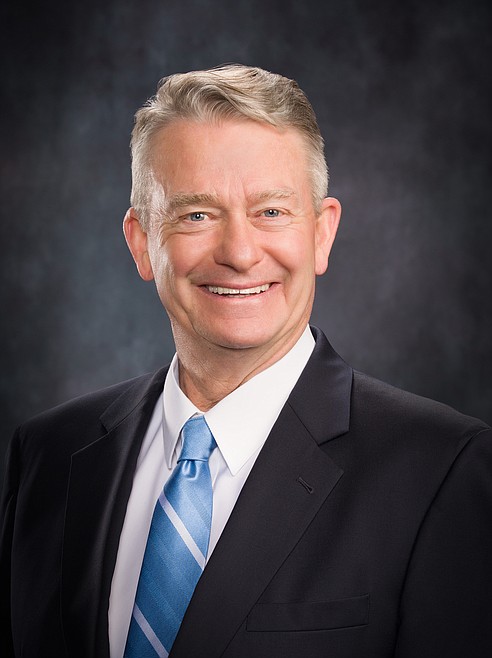Little administration optimistic after first wave of vaccine
Gov. Brad Little gave cautious optimism Tuesday afternoon about the abilities of a pair of vaccines to end the plight of COVID-19.
“The rollout of the vaccine,” Little said in an open conference call, “and the fact we have our critical health providers building antibodies every second we sit here today is a sign that we’ve really turned a corner. It doesn’t mean we’re out of the woods by any stretch of the imagination, but given the efficacy of these new vaccines — the second one is just arriving here today — it really gives us great hope.”
Little’s words came less than a day after he told the Post Register out of Idaho Falls that the new COVID-19 vaccines could help bring life back to normal after four months, statements that echo other Idaho politicians’ sentiments, including that of U.S. Sen. Jim Risch. The four phases of vaccine distribution begin with front line health care workers, followed by residents and staff at long-term care facilities.
Dave Jeppesen, director of the Idaho Department of Health and Welfare, said he felt great relief to finally post good news on the state’s coronavirus tableau: the number of vaccinated Idahoans, a number that currently sit at 5,665 health care workers statewide.
“This is a pretty big moment,” Jeppesen said on Tuesday’s conference call. “Near as we can tell, Idaho is the first state in the nation to report how many have been vaccinated.”
The number of vaccinated Idahoans wasn’t the only good news Jeppesen’s department reported. Testing positivity took a step in the right direction over the weekend, with positivity rates dropping from 20 percent to 16.5 percent.
“Obviously we’d like that to be closer to 5 percent,” he said, “so we’re still a long ways away from our goal. But it’s good to see at least one week where it’s headed in the right direction.”
After Idaho received its initial dose of more than 13,000 doses of the Pfizer vaccine shortly after its mid-December approval, the state — as well as every other state in the union — received unfortunate news that the drug company wouldn’t be able to satisfy its expected second run in full. Instead of receiving a second batch of 17,550 doses, Jeppesen’s department announced it would receive a second batch of 9,750 by year’s end.
The Moderna vaccine, meanwhile, was granted its emergency use authorization Friday by the Food and Drug Administration. Idaho’s seven health districts are expected to receive the 28,000 doses of Moderna by year’s end.
Both Moderna and Pfizer developed first-of-their-kind vaccines, not only because of the novelty of their target virus, but also because of the mechanisms the vaccines promise to employ. The two COVID-19 vaccines are what are known as mRNA, according to the Centers for Disease Control. The CDC says that, unlike other vaccines against viruses such as the flu or measles that contain live or active strains of their diseases, the authorized COVID vaccines produce what’s known as a “spike protein” on the surface of the coronavirus, which triggers the body to build antibodies against the new COVID proteins. That mRNA, the FDA said, dissolves within a day or two.
According to the FDA, aside from the mRNA, the Moderna vaccine contains:
• lipids, which help facilitate the delivery of the mRNA,
• acetic acid, sodium acetate and sucrose, which all work as stabilizers to mitigate acidity long enough for the vaccine to take hold, and
• tromethamine and tromethamine hydrochloride, which also serve as stabilizers.
The Pfizer vaccine, meanwhile contains the mRNA and lipids, as well as:
• potassium chloride,
• monobasic potassium phosphate,
• sodium chloride,
• dibasic sodium phosphate dihydrate, and
• sucrose.
The FDA said the sucrose, sodium phosphate dihydrate, sodium chloride, potassium chloride and potassium phosphate all stabilize the pH balance of the vaccine until the mRNA and lipids take hold. Jeppesen said that he is particularly excited about the Moderna vaccine, simply because it does not require the same freezing requirements necessary in Pfizer’s -70 degree Celsius conditions.
“That’s colder than the freezer in my garage, and probably yours, as well,” Jeppesen said, “so that makes it just a little more challenging. While the Moderna vaccine just requires a regular freezer temperature, so that’s going to be helpful, and probably what we’ll use heavily in the rural areas, because they come in smaller packages, and they require just a regular freezer to handle those.”
Jeppesen said he expects mild side effects among the vaccinated population, most noteably a sore arm at the point of vaccination, and that occasional symptoms have emerged in clinical trials.
“In some people, there are some symptoms that develop as a reaction to the vaccine,” Jeppesen said. “Either fatigue or a headache or some muscle pain. In a few people, it can even cause a fever. Those symptoms are not common but to be expected among some, and they go away in a day or two.”
The timelines for vaccinations among the rest of the population have not yet been determined, Jeppesen said, in part because of wavering production schedules.

